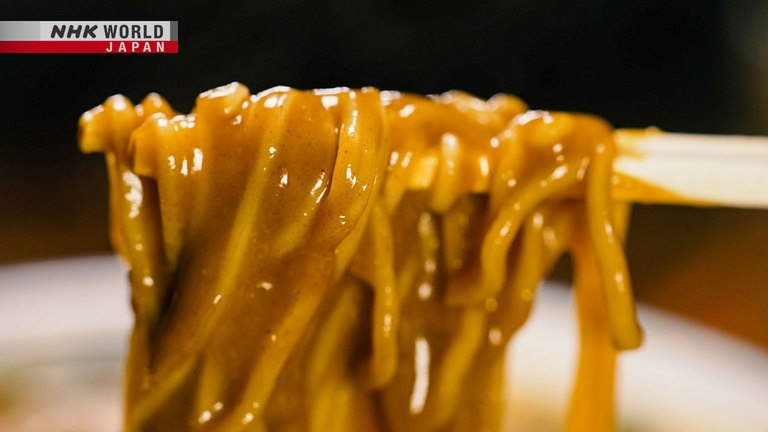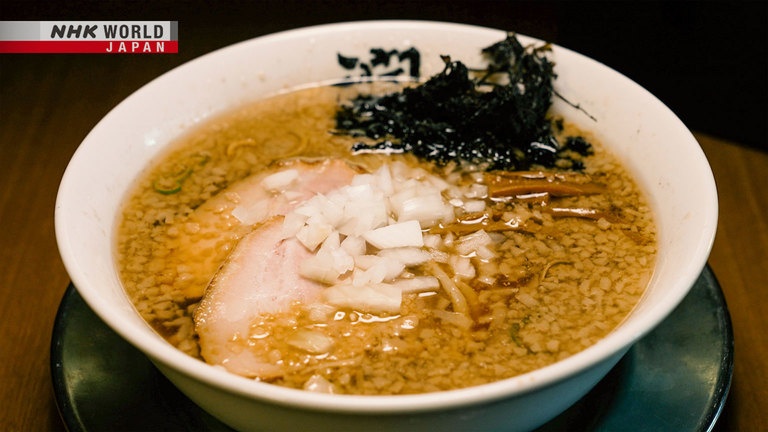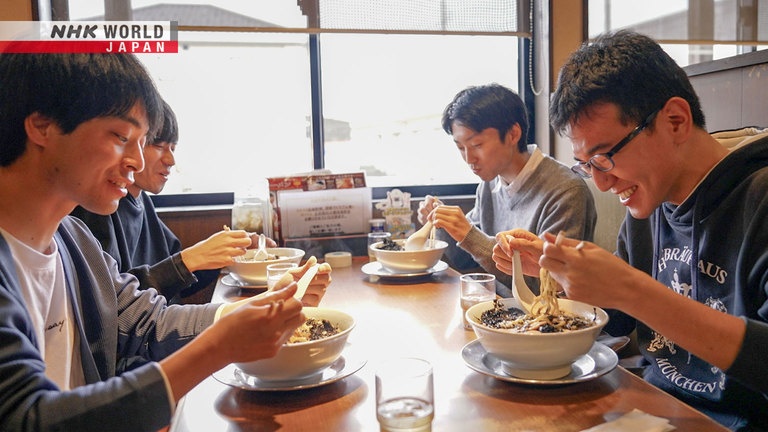NIIGATA Part 2
Niigata Prefecture's Sanjo City is considered the birthplace of curry ramen. A metalworking city, it also produces ramen utensils!




Transcript
We're back with part two of our Niigata ramen journey.
This time we'll try two styles with different tastes and features that originated in adjacent cities.
Welcome to Japan, the land of ramen!
Tsubamesanjo Station is located near the center of Niigata prefecture.
On the station's east side is Sanjo.
On its west is Tsubame.
Let's start with Tsubame.
One of Japan's leading manufacturing regions,
Tsubame has been prominent in metalwork for centuries.
Tsubame boasts Japan's number one position in the metal utensil trade,
shipping goods nationwide and abroad.
The city also produces items essential to making ramen.
This product is called "tebo."
It's a utensil used to make one portion of noodles at a time.
This manufacturer offers options with differing mesh and volume sizes.
Seventy percent of ramen shops throughout Japan use their "tebo."
What does the ramen beloved by the people of Tsubame taste like?
We'll have magazine editor Katayama Takahiro,
who's eaten 4,000 bowls of Niigata ramen over the course of 20 years, show us.
It has an impact at first glance.
The surface is totally white!
The noodles, soup,
and toppings are all distinctive.
It's one of Japan's most unique bowls of ramen.
Tsubame ramen began at this shop.
Third-generation owner, Jo Naoyuki.
Setting Tsubame ramen apart is the generous amount of pork backfat placed on top.
After pouring the soup, we finish it off
with splashes of pork backfat.
The broth under the backfat
is dried sardine-based.
It's quite mild.
Taken in with the surface fat,
the soup is balanced well.
It's a well calculated dish.
Five millimeters wide, the noodles are extra thick.
We use our own handmade noodles.
The flour is kneaded with a large amount of water that makes the noodles thick and chewy.
Lots of powdered starch is used
so the noodles don't stick together.
The rest is a company secret.
The toppings are also distinctive!
We use onions instead of green onions.
Onions taste sweeter.
They go better with
salty and punchy soups.
It looks very greasy,
but it's not that heavy.
It's ramen anyone can eat.
I can't live without it.
It's my comfort food.
I've eaten around but this is the best.
How did this one-of-a-kind ramen come about?
My grandfather was Chinese.
He came to Tsubame with a ramen cart.
Jo Shousei came to Japan around 1930.
He got hold of a food cart and eventually established a ramen shop in Tsubame.
It was standard ramen in the beginning.
Typical ramen with thin noodles
and light soup, like in Niigata City.
Shousei's encounter with pork backfat was coincidental.
He walked into a butcher shop
and saw lots of pork backfat.
After learning it would be thrown away,
he asked if he could have it.
He cooked the fat into the soup and
it turned out to be a great ingredient.
That's how this soup was born.
Second-generation owner Jo Katsuji took the next step by focusing on the noodles.
The 1960s, Japan's period of high economic growth.
Orders from local factories flooded in.
However, the noodles would soften during delivery.
Dad didn't like serving soft noodles
and wondered how to resolve this.
He thought thicker noodles
would keep them firm.
They were so thick, customers
thought they'd gotten udon by mistake!
From the trials and errors of the first two generations, Tsubame Ramen was perfected.
This development continues with the current generation.
This shop's feature is the amount of backfat served.
We got requests for more backfat.
Customers can choose the amount.
Standard pork backfat ramen already has plenty of fat.
But order the demon amount and...
It's totally white.
As much as possible is added to make demon style.
A group of four have come from Tokyo.
I visit every other month.
I've been coming for about four years now.
It looks greasy, but it really isn't.
- My stomach is excited!
- Mine's in bliss.
This small factory in Tsubame has been operating for 60 years.
Delivery!
Let's eat.
In the old days, we'd order in
rather than go to the shop.
We'd fill our bellies
before the overtime shift.
People in Tsubame grew up on this.
I went to high school in another city.
When I first ate a regular ramen
there was something lacking.
- It's delicious!
- Hunger is the best spice!
Tsubame Ramen, created to meet the needs of the city's workers, continues to fill their stomachs.
Let's hop over to Sanjo on the station's east side.
We conclude our trip around the Ramen Kingdom of Niigata with this unique bowl.
Here, they've been serving this style for many years.
The customers are eating...
Curry ramen.
Owner Yagi Kosuke's grandfather opened a shop in 1933 and started serving curry ramen.
The taste has been handed down through the generations.
I'm amazed my grandfather
came up with such a fantastic menu.
Let's take a look at how they make it.
It begins with the curry roux.
We use flour, lard and
salad oil to make roux.
I heat and stir until
it's browned but not burnt.
Alternating my right and left arms,
I do this for about an hour.
And this is how ramen is made.
Before the war, we couldn't
get ready-made curry roux.
We used cummin, coriander
and other available spices.
He mixes the curry roux with fish-based broth.
It's topped with onions and roasted pork.
It's almost too simple!
It's only curry over noodles
but it's perfectly matched.
It tastes awesome.
It's perfect for cold weather.
You can eat it every
day and not tire of it.
I'm very proud of it.
The origin of curry ramen is unknown.
It was born before
the word "ramen" existed.
I've heard it was on our menu by 1937.
Today, more than 30 shops in the city offer curry ramen.
There are no fixed of rules for curry ramen.
For example, curry ramen with pork cutlet on top.
Or you can have rice placed under the noodles.
It's a staple food for us but some
are amused by "curry flavored ramen."
Abe Keisaku is the chairperson of The Sanjo Curry Ramen Club,
a group made up of ramen shop owners.
How did curry ramen begin?
There are all kinds of theories.
As a metal industry city,
its workers regularly ordered food delivery.
Some may have ordered ramen and
curry rice, and ate them together.
They might have liked the twist.
Then each shop developed
their distinctive style.
In an attempt to introduce curry ramen across Japan, Abe founded the club in 2008.
Since then, he's actively promoted this style of ramen.
When I say I'm from Sanjo,
people say, "Ah, curry ramen!"
I feel proud when hearing this.
When first trying it, people say
it doesn't leave an impression.
But eventually they come back for more.
This happy couple has come from the outskirts of Tokyo.
We're visiting her grandmother
to tell her about our engagement.
It's my second time here.
It's really good.
She said I had to try this curry ramen.
The engagement stuff made me tense.
But we did what we came to do.
A special bowl on a special day.
May these two find lasting happiness.
Niigata has long served Japan's food culture.
The region's snowy climate and industry have given birth to five beloved types of ramen.
Wouldn't you like to try some yourself?
Come visit for the best bowl of ramen you've ever had!